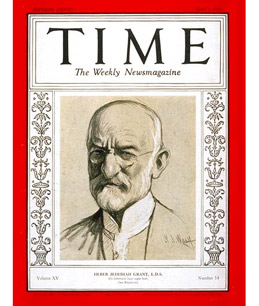
In the State of Utah the rock of ages has assumed strange forms.
Geologically, as observed in such scenic reservations as Bryce Canyon
National Park, The Cedar Breaks, Zion National Park ,
the rock has been sculptured by erosion, forming unearthly peaks and
terraces, ornate gorges, petrified and ghostly cities. Utah's religious
rock of ages—its dominant church—is equally exotic. It is, as
everyone knows, the Church of Jesus Christ of Latter-day Saints, or,
more familiarly, the Mormon Church. Fully half of Utah's half-million
souls are Mormons. The history and commercial development of Utah is
more closely linked with the Mormon Church than is Roman history with
Catholicism. Last week the thoughts of all the 700,000 Mormons in the world dwelt in
Salt Lake City, capital of Mormondom and of Utah, where the centenary
of the founding of the Church was to be celebrated, exactly to the day,
on April 6, 1930. A week of exercises and formal rejoicing was
scheduled to follow. Holy rites of celebration would be secretly performed in the
six-spired Mormon Temple, open only to Mormon church-members in good
standing , and thus long supposed by superstitious
Gentiles* to conceal queer ceremonies of polygamous import. But
Mormonism is by no means merely a closeted, holy matter. It is also a
hard-headed economic system and the communicants are bustling,
practical, prosperous. Always have non-Mormons been welcomed to
services and organ recitals in the great domed Tabernacle just behind the Temple. This auditorium, where the
late great Soprano Adelina Patti remarked: “My voice is twice as large
here,” had undergone last week a vast refurbishing for a public pageant
calculated to impress its audiences with the fact that Mormonism is a
successful religion if ever there was one. Accompanying the pageant
would be music from one of Mormondom's most cherished treasures—
its
mighty organ. In 1866 oxen began hauling the logs which formed its
32-foot diapason, its tiny flutinos. Glue was made by boiling strips of
cattle and buffalo hides. Recently reconstructed, the instrument, with
5,500 pipes, is among the world's largest, draws comparisons with those
in Frieburg, London's Crystal Palace, Manhattan's St. Patrick's
Cathedral. Designed on a monumental, historic scale, the pageant would
begin, of course, in Heaven, where the Creator's appointment of Jesus
as a Redeemer was to be represented with luminous effects and
invisible voices. Next would be shown the creation of the world and its
peoples; the ancient prophets; the Nativity, Sermon on the Mount,
Resurrection. Then would follow the dark period of apostasy and,
finally, the story of Mormonism: